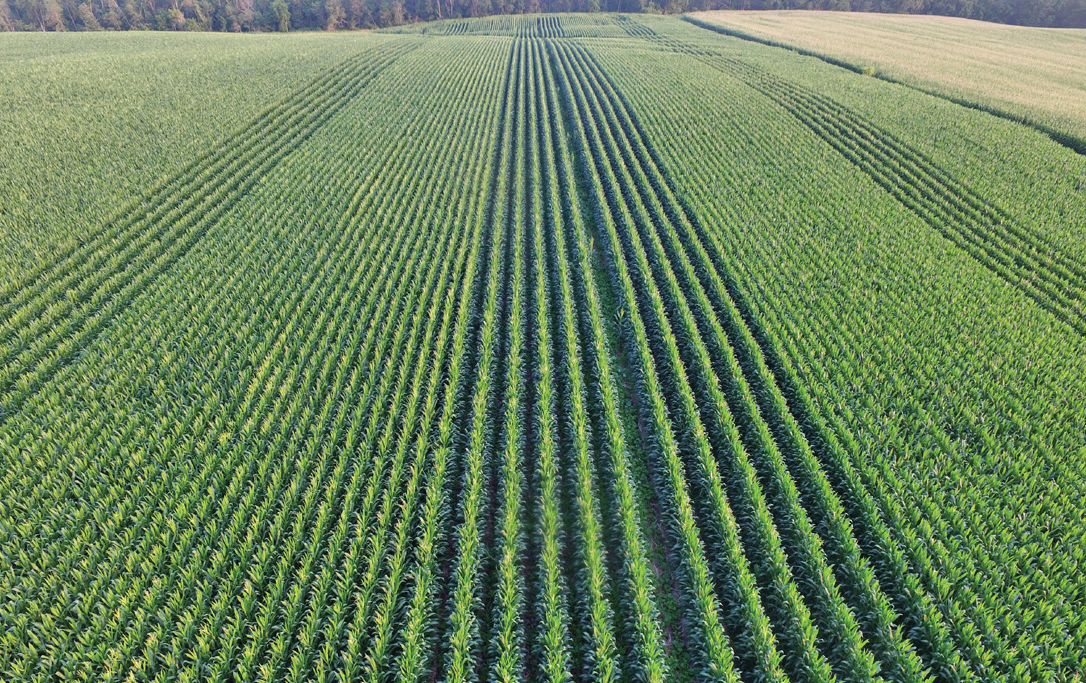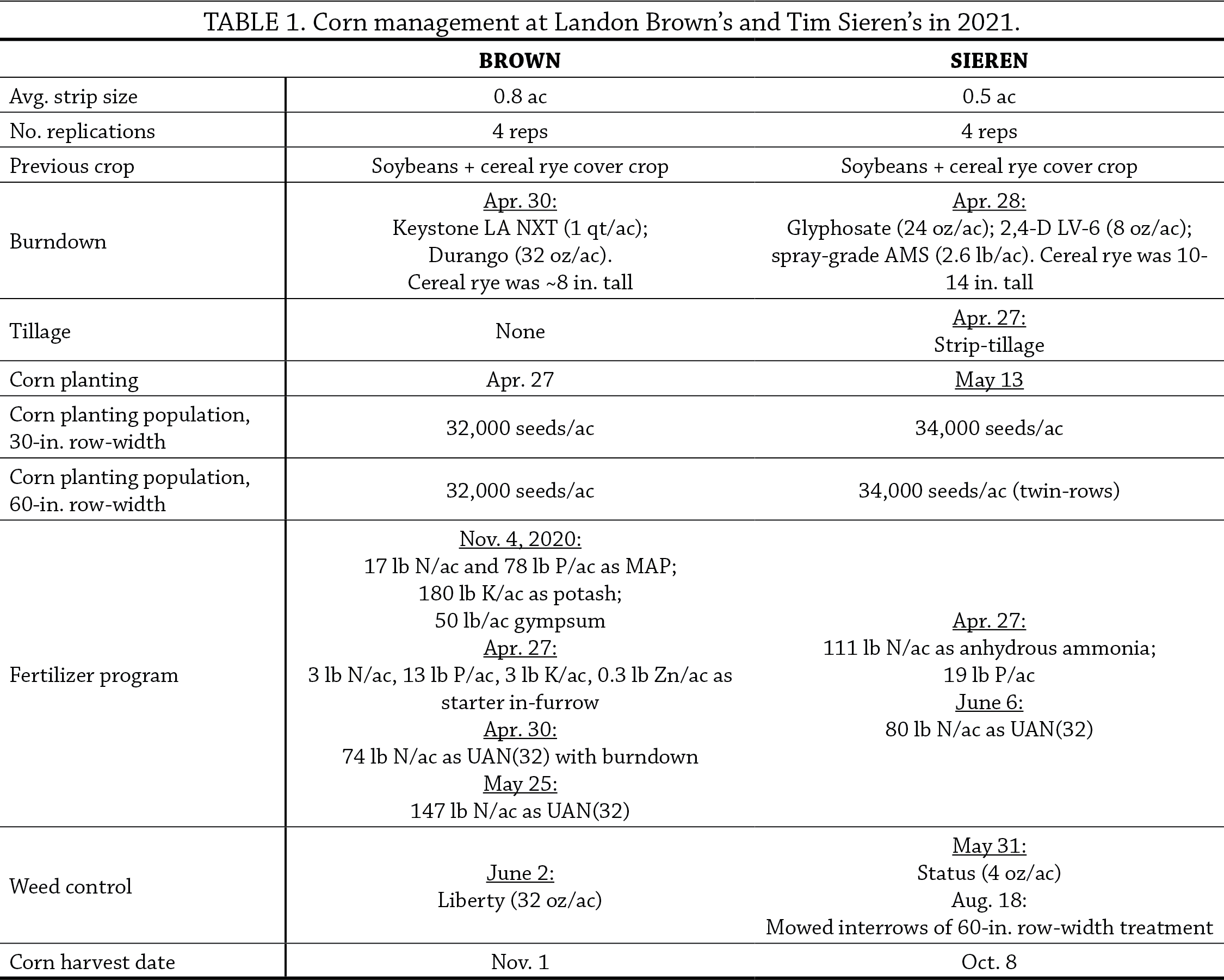This research was funded by Walton Family Foundation and USDA-NRCS.
In a Nutshell:
- This was the fourth year of on-farm research trials designed to evaluate planting corn in 60-in. row-widths for the purpose of improving the success of interseeding cover crops to the corn in early summer, while maintaining corn grain yield.
- Landon Brown and Tim Sieren planted corn in two row-widths (30- and 60-in.) and compared corn yields between the two row-widths. Brown additionally compared interseeded cover crop biomass production between the two row-widths.
Key Findings:
- At both farms, planting corn in 60-in. row-widths reduced corn yields by 47 bu/ac compared to planting corn in 30-in. row-widths.
- After four years of trials, corn yields from 60-in. row-widths have been reduced on average by 13% compared to corn grown in 30-in. row-widths.
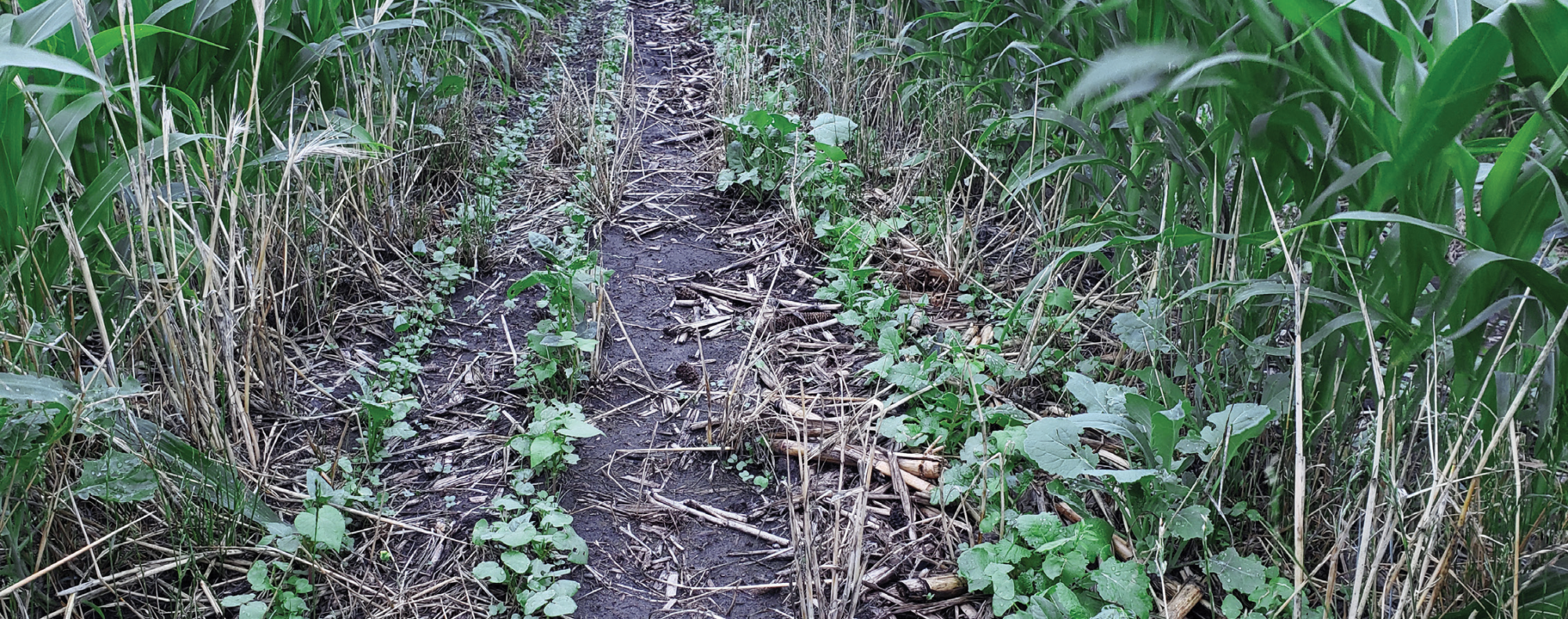
A cover crop mix grows between 60-in.-wide corn rows at Landon Brown’s on June 26, 2021. The corn was planted on Apr. 27 and the cover crops were interseeded on June 3.
Background
Widening the corn row is a version of the solar corridor crop system concept which “is designed for improved crop productivity based on highly efficient use of solar radiation by integrating row crops with drilled or solid seeded crops in broad strips (corridors) that also facilitate establishment of cover crops for year-round soil cover.”[1] Previous PFI on-farm research from 2018–2020, saw five farms report no difference in corn yields between the 30- and 60-in. row-widths, while 10 other farms reported yields reduced by 6 to 30% in the 60-in. row-widths compared to the 30-in. row-width.[2–4] These mixed results aligned with previous research from the University of Missouri that found equivalent corn yields between 30- and 60-in. row-widths in one year and yields reduced by 14 to 39% in the 60-in. row-widths in two other years.[5] The reports of 2,500 to 4,600 lb/ac of cover crop biomass by the time of corn harvest with 60-in.-wide corn rows from the previous three years of on-farm research is particularly appealing to those wishing to graze livestock in the fall. That certainly appealed to Landon Brown, who also raises sheep and cattle on the farm. He conducted the trial because he was eager to “try a different practice that might change the way my farm operates down the road.” Tim Sieren conducted the trial for a second time after seeing significant yield drag from the 60-in. row-widths in 2020 with the hope of “increasing soil health, while increasing the amount of fall grazing available, without giving up acres for row crops.”
Methods
Design
Each cooperator planted randomized and replicated strips of corn in 30- and 60-in. row-widths and then interseeded cover crops to all strips in early summer (Figure A1). Strips at each farm were as wide as at least one combine pass and ran the length of the field. Corn management at all farms is provided in Table 1.
Brown used a twin-row seeder to interseed a cover crop mix to both row-width treatments on June 3: annual ryegrass (6 lb/ac); crimson clover (2.3 lb/ac); berseem clover (2.3 lb/ac); lentils (2.3 lb/ac); rapeseed (0.8 lb/ac); radish (0.8 lb/ac); turnips (0.8 lb/ac). Sieren planned to interseed cover crops but unfortunately was not able to do so. Dry conditions that predominated early June would have precluded any cover crop growth and the corn was too tall to perform interseeding after substantial recharging rainfalls occurred in late June.
Measurements
Brown assessed aboveground cover crop biomass near corn maturing on Sept. 19 by clipping shoot and leaf material from 1-ft × 1-ft quadrats placed in the strips. Samples were stored in paper bags and air-dried for at least one month before determining dry biomass. Both Brown and Sieren harvested corn individually from each strip and grain yields were corrected to 15.5% moisture.
Data analysis
To evaluate any effect of corn row-width on corn yield, we calculated the least significant difference (LSD) at the 95% confidence level using a t-test. If the difference in average yield between the two row-width treatments was greater than the LSD, we would expect such a difference to occur 95 times out of 100 under the same conditions – we refer to this as a statistically significant effect. On the other hand, if the difference resulting from the two treatments was less than the LSD, we considered the results statistically similar. We could make these statistical calculations because the cooperators’ experimental designs involved replication of the two corn row-widths (Figure A1).
Results and Discussion
Cover crop biomass
Brown observed nearly five times as much cover crop biomass in the 60-in. row-width treatment (2,113 lb/ac) compared to the 30-in. row-width treatment (432 lb/ac). The biomass from the 60-in. row-width treatment is similar to that which previous cooperators have observed.[2–4]
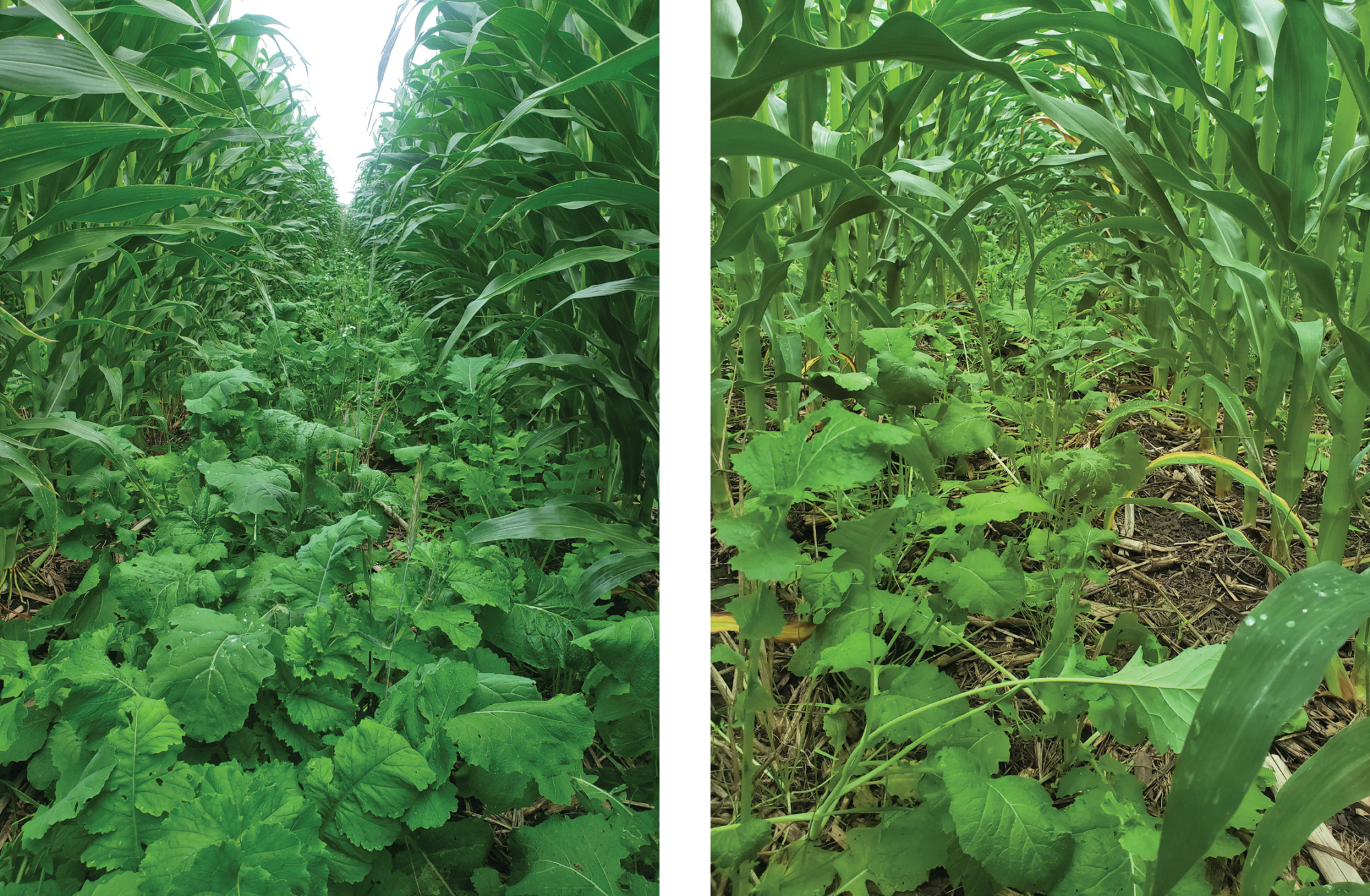
Interseeded cover crops grow between 60-in.-wide corn rows (left) and 30-in.-wide corn rows (right) at Landon Brown’s on July 14, 2021
Corn yields
Compared to planting corn in 30-in. row-widths, planting corn in 60-in. row-widths reduced corn yields by 47 bu/ac at both farms (Figures 1 and 2). This amounted to a yield reduction of 18% at Brown’s and 20% at Sieren’s.
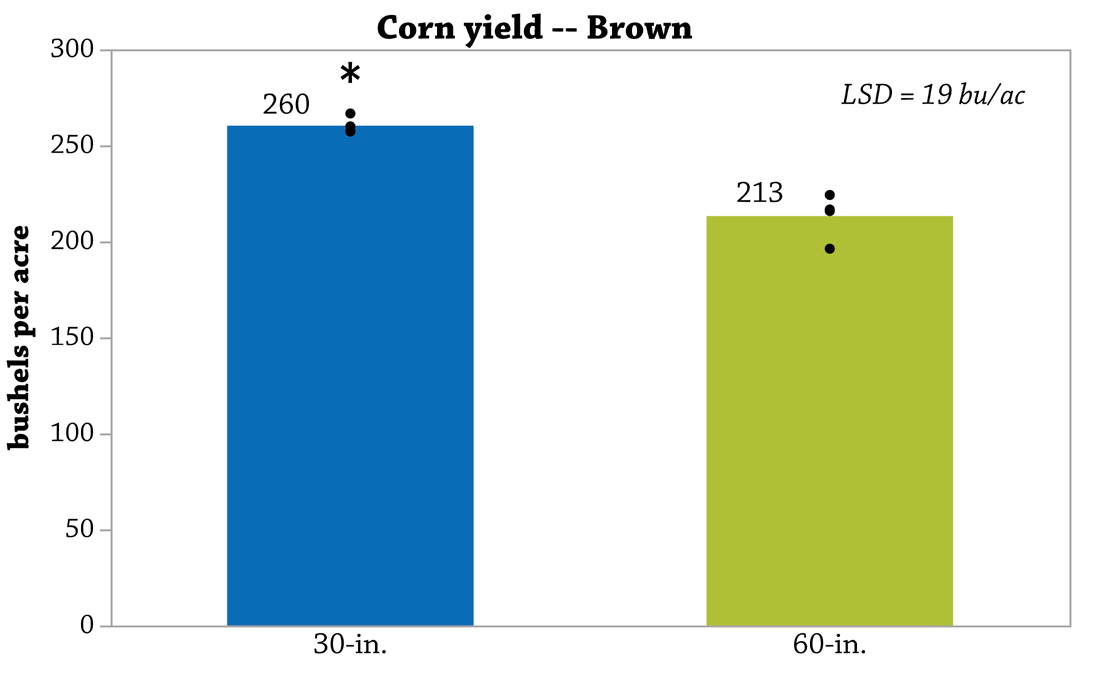
FIGURE 1. Corn yields as affected by row-width at Landon Brown’s in 2021. Columns represent treatment means at each farm; points represent the yield from individual strips. Asterisk (*) indicates that the differences in corn yield were greater than the least significant difference (LSD = 19 bu/ac), indicating a statistically significant difference at the 95% confidence level.

FIGURE 2. Corn yields as affected by row-width at Tim Sieren’s in 2021. Columns represent treatment means at each farm; points represent the yield from individual strips. Asterisk (*) indicates that the differences in corn yield were greater than the least significant difference (LSD = 8 bu/ac), indicating a statistically significant difference at the 95% confidence level.
The lower yields in 60-in. row-widths mirror previous on-farm findings from 2018–2020[2–4] as well as research conducted at the University of Missouri in 2005, 2006 and 2011.[5] Figure 3 depicts the effect of 60-in. row-widths on corn yields from all 17 on-farm sites from 2018 to 2021. Over that period, we have observed statistically similar yields in only five instances (error bars encompass 0 in the figure). On average, corn yields from 60-in. row-widths have been reduced by 13% compared to corn grown in 30-in. row-widths.

FIGURE 3. Effect on corn yield of 60-in. row-widths from all 17 sites from 2018 to 2021 as well as the overall mean. Points represent the average percent change in corn yield resulting from 60-in. row-widths compared to 30-in. row-widths. Error bars represent 90% confidence intervals. Width of bars indicate the amount of variation (the wider the bars, the more variation). Bars that encompass 0 indicate no statistical difference in yield between 60- and 30-in. row-widths. Bars that do not encompass 0 indicate significant yield decline resulting from 60-in. row-widths.
Conclusions and Next Steps
After four years of on-farm research, planting corn in 60-in. row-widths has resulted in statistically lower grain yields than corn planted in 30-in. row-widths in 12 of 17 trials. Brown might try the practice again on what he describes as a lower quality field on his farm and also try other cover crop species to interseed. After two years of experimenting, Sieren, on the other hand, does not anticipate trying 60-in. row-widths again “I tried it last year for the first time and it was a learning experience. This was my second year in the trial, and I can’t justify the yield reduction I’ve had both times,” he said.
Both Brown and Sieren were excited about the potential for increased fall forage from interseeding cover crops to corn in 60-in. row-widths. Brown certainly saw that potential with the amount of cover crop he observed in September. Even so, weed management when planting in wide rows can be challenging. “If wide-row corn has taught me anything, it’s that my cropping system relies on a good crop canopy as part of the weed control,” Sieren said. “I’ve decided to concentrate on tweaking my three-year rotation practice with small grains and legumes in the rotation, which is much more compatible with my cow herd, my time constraints, my soil health goals and my farm’s profitability.”
Appendix – Trial Design and Weather Conditions
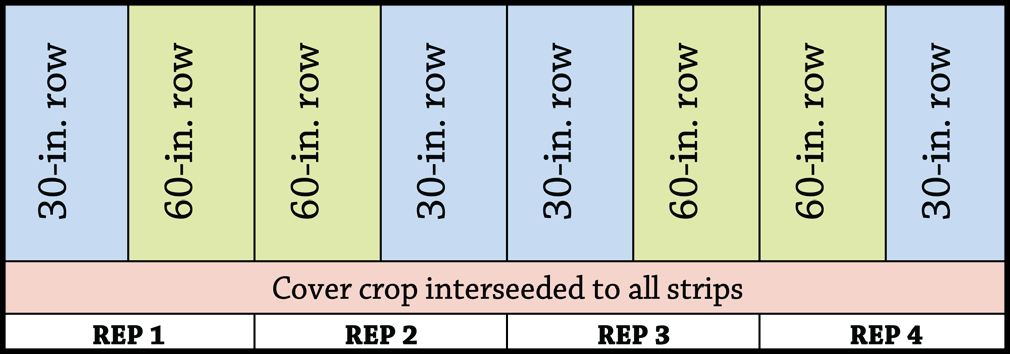
FIGURE A1. Sample experimental design used by the cooperators. The design includes at least four replications of the two corn row-width treatments (8 strips total). This design allowed for statistical analysis of the results.
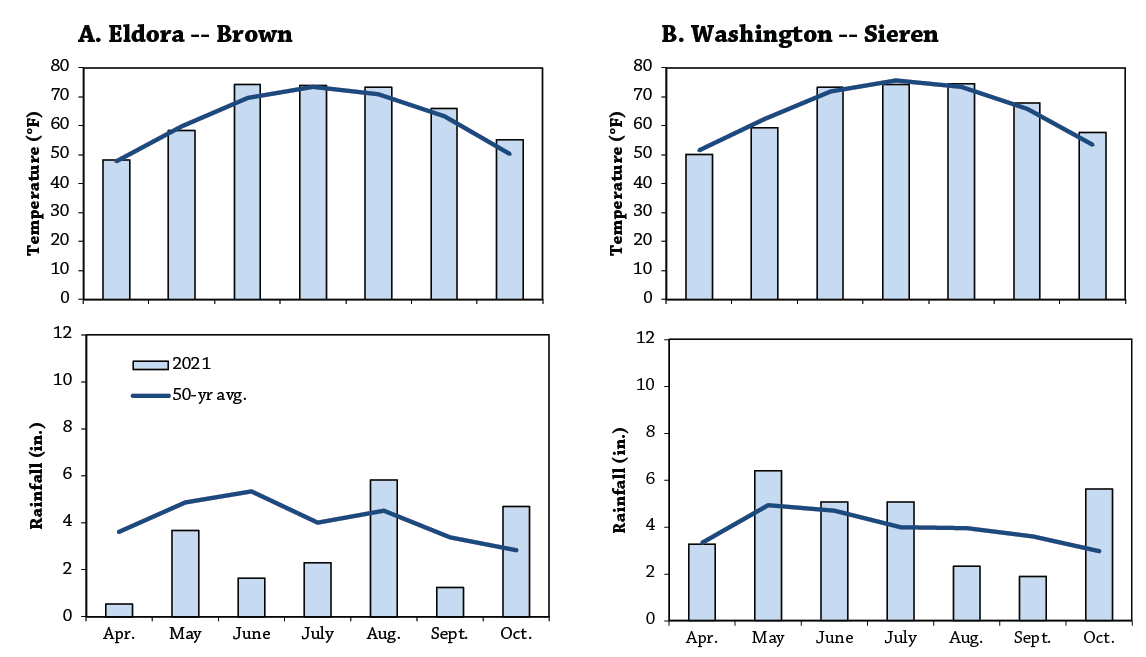
FIGURE A2. Mean monthly temperature and rainfall for 2021 and the long-term averages at the nearest weather stations to each farm.[6] A) Eldora (Brown); B) Washington (Sieren).
Funding Acknowledgement
This material is based upon work supported by the Natural Resources Conservation Services, U.S. Department of Agriculture, under number NR186114XXXXG003. Any opinions, findings, conclusions, or recommendations expressed in this publication are those of the authors and do not necessarily reflect the views of the U.S. Department of Agriculture.
References
- Kremer, R.J. and C. LeRoy Deichman. 2014. Soil quality and the solar corridor crop system. Agronomy Journal. 106:1853–1858. https://www.researchgate.net/profile/Robert_Kremer/publication/266141259_Soil_Quality_and_the_Solar_Corridor_Crop_System/links/5426cfc10cf26120b7b3449b/Soil-Quality-and-the-Solar-Corridor-Crop-System.pdf (accessed November 2021).
- Gailans, S., J. Boyer, F. Abels, C. Teachout, B. Kessel, H. Kessel and J. Johnson. 2018. Planting Corn in 60-in. Row-Widths for Interseeding Cover Crops. Practical Farmers of Iowa Cooperators’ Program. https://practicalfarmers.org/research/planting-corn-in-60-in-row-widths-for-interseeding-cover-crops/
(accessed November 2021). - Gailans, S., F. Abels, R. Alexander, N. Anderson, J. Boyer and M. Yoder. 2019. Planting Corn in 60-in. Row-Widths for Interseeding Cover Crops. Practical Farmers of Iowa Cooperators’ Program. https://practicalfarmers.org/research/planting-corn-in-60-in-row-widths-for-interseeding-cover-crops-2/ (accessed November 2021).
- Gailans, S., F. Abels, N. Anderson, J. Olson, T. Sieren and M. Yoder. 2020. Planting Corn in 60-in. Row-Widths for Interseeding Cover Crops. Practical Farmers of Iowa Cooperators’ Program. https://practicalfarmers.org/research/planting-corn-in-60-in-row-widths-for-interseeding-cover-crops-3/ (accessed November 2021).
- Nelson, K.A. 2014. Corn yield response to the solar corridor in upstate Missouri. Agronomy Journal. 106:1847–1852. https://dl.sciencesocieties.org/publications/aj/abstracts/106/5/1847 (accessed November 2021).
- Iowa Environmental Mesonet. 2021. Climodat Reports. Iowa State University. http://mesonet.agron.iastate.edu/climodat/ (accessed November 2021).


